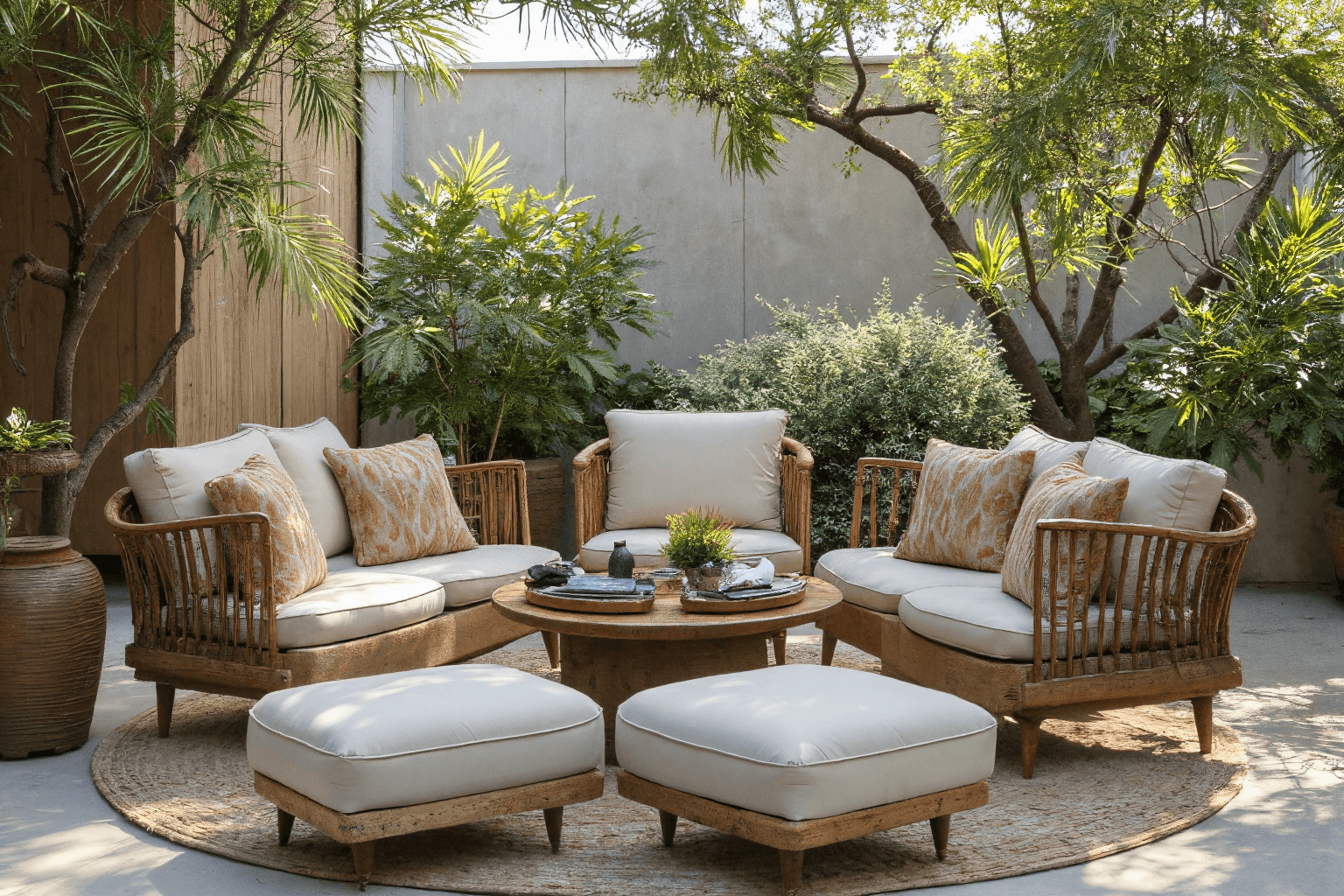Introduction: The Rise of the Outdoor Sanctuary
The once-distinct line between indoor and outdoor living is rapidly dissolving, giving rise to a new era where the outdoors is no longer just an adjunct to the home but an integral, luxurious extension of it. Affluent homeowners are increasingly investing in transforming their patios, decks, and gardens into sophisticated outdoor havens that rival the comfort and style of their interior spaces. This trend, propelled by advancements in technology, sustainable materials, and a growing desire for personalized, immersive experiences, is set to reach new heights in 2025.
No longer simply a space for casual gatherings, the luxury outdoor area is now envisioned as a multi-functional sanctuary for relaxation, entertainment, and even work, seamlessly blending the boundaries between indoors and out. A recent survey by the American Institute of Architects revealed a 65% increase in client requests for high-end outdoor living spaces in the past year, indicating a substantial shift in homeowner priorities. This surge in demand reflects a growing appreciation for the restorative power of nature and the desire to create private retreats that offer respite from the pressures of modern life.
This evolution in outdoor living is driven by a confluence of factors, including the rise of biophilic design principles, which emphasize the integration of natural elements into the built environment. Homeowners are seeking to create spaces that foster a deeper connection with nature, incorporating lush landscaping, water features, and natural materials like sustainably sourced wood and stone. Furthermore, the increasing availability of sophisticated outdoor technologies, such as smart lighting systems, weather-resistant audio-visual equipment, and automated climate control, has made it possible to create outdoor spaces that are as comfortable and functional as any indoor room.
Leading brands like Dedon and Brown Jordan are at the forefront of this movement, offering luxurious outdoor furniture collections that combine high-performance materials with elegant, contemporary designs. These pieces are not merely weather-resistant but are designed to withstand the elements while maintaining their aesthetic appeal, ensuring long-lasting beauty and functionality. The emphasis on sustainability is another defining characteristic of luxury outdoor design in 2025. Eco-conscious homeowners are prioritizing environmentally friendly materials, such as reclaimed wood, recycled plastics, and sustainably sourced stone, to minimize the environmental impact of their outdoor spaces.
Energy-efficient solutions, including solar-powered lighting and appliances, are also gaining traction, further reducing the carbon footprint of these luxurious retreats. This commitment to sustainability extends beyond material choices to encompass the overall design approach. Landscape architects are increasingly incorporating principles of xeriscaping and rainwater harvesting to create water-wise gardens that conserve precious resources. The integration of native plants and the creation of habitats for local wildlife further enhance the ecological integrity of these outdoor spaces.
High-end outdoor living in 2025 is not just about creating beautiful spaces; it’s about creating spaces that are both luxurious and responsible, reflecting a growing awareness of the interconnectedness between personal well-being and environmental stewardship. This comprehensive guide explores the emerging trends and innovations shaping high-end outdoor living, offering inspiration and practical advice for creating your own outdoor oasis. From cutting-edge entertainment systems to comfort-enhancing accessories and sustainable design practices, we delve into the elements that define the future of luxurious outdoor spaces. Government incentives and policies, such as tax credits for energy-efficient outdoor appliances and landscaping, are also playing a role in encouraging homeowners to invest in sustainable outdoor upgrades, further fueling the growth of this market.
Emerging Trends in Luxury Outdoor Furniture Design
Luxury outdoor furniture in 2025 is defined by a seamless blend of aesthetics, durability, and sustainability. Expect to see a greater emphasis on weather-resistant materials like recycled teak, powder-coated aluminum, and innovative synthetic weaves that mimic the look and feel of natural fibers. Leading brands such as Dedon, Brown Jordan, and Gloster are pioneering designs that prioritize both comfort and environmental responsibility. For instance, Dedon’s ‘Earth to Earth’ collection uses 100% recycled ocean plastic, while Brown Jordan’s ‘Oscar’ series features frames made from recycled aluminum.
Craftsmanship remains paramount, with many pieces handcrafted by skilled artisans. Modular designs are also gaining popularity, allowing homeowners to customize their outdoor spaces to suit their specific needs and preferences. Expect to see more collaborations between furniture designers and landscape architects, resulting in outdoor furniture that seamlessly integrates with the surrounding environment. This commitment to sustainability extends beyond material choices. Designers are increasingly focusing on the lifecycle of their products, creating pieces that are not only durable but also easily repairable and recyclable.
The concept of ‘circular design’ is gaining traction, with manufacturers offering take-back programs and utilizing modular construction to facilitate component replacement and upgrades. This approach minimizes waste and extends the lifespan of luxury outdoor furniture, aligning with the growing demand for eco-friendly outdoor design. Beyond sustainability, the integration of technology is subtly enhancing the luxury outdoor experience. Some high-end outdoor living furniture now incorporates hidden charging stations for electronic devices, integrated lighting systems, and even Bluetooth-enabled speakers.
These features are seamlessly embedded into the design, maintaining a clean and sophisticated aesthetic while providing added convenience. For example, certain collections offer chaise lounges with built-in solar panels to power device charging, exemplifying the fusion of sustainability and technological innovation. Smart outdoor lighting is also playing a key role, with systems that automatically adjust brightness based on ambient light levels and can be controlled remotely via smartphone apps. Ergonomics and comfort are also taking center stage in outdoor design trends 2025.
Luxury outdoor furniture is no longer just about aesthetics; it’s about providing a truly relaxing and supportive experience. Expect to see deeper seating, higher backs, and more generous cushioning, often utilizing high-performance outdoor fabrics that are both weather-resistant and incredibly soft to the touch. Many manufacturers are partnering with ergonomists to ensure their designs promote proper posture and reduce strain, creating outdoor furniture that is as comfortable as it is stylish. The focus is on creating an outdoor sanctuary where homeowners can truly unwind and escape the stresses of daily life.
The architectural integration of outdoor furniture is another key trend. Landscape architects are working closely with furniture designers to create cohesive outdoor spaces where the furniture complements the surrounding landscape and architectural features of the home. This includes selecting materials and colors that harmonize with the natural environment, as well as carefully considering the placement of furniture to maximize views and create a sense of flow. Custom-designed outdoor kitchens and bars are becoming increasingly popular, blurring the lines between indoor and outdoor spaces and creating seamless transitions between the home and the garden. This holistic approach to outdoor design elevates the entire outdoor living experience, transforming patios and decks into true extensions of the home.
Cutting-Edge Outdoor Entertainment Systems
The integration of advanced technology is revolutionizing outdoor entertainment, blurring the lines between indoor comfort and open-air experiences. Luxury homeowners are no longer content with simple patios; they demand immersive outdoor havens equipped with cutting-edge technology that seamlessly integrates with the natural landscape. Integrated audio-visual setups are now incredibly sophisticated, transforming patios into high-end outdoor cinemas and entertainment hubs. Weatherproof, high-definition screens from brands like Séura withstand the elements while delivering stunning visuals, creating a true cinematic experience under the stars.
Furthermore, immersive sound systems from companies like Sonance provide discreet, high-performance audio that blends seamlessly into the surrounding architecture and landscape, ensuring that the focus remains on the beauty of the outdoors. This trend reflects a broader shift in luxury living, where technology enhances rather than intrudes upon the natural environment. Smart lighting solutions further elevate the ambiance and functionality of luxury outdoor spaces. Controllable via smartphone apps or voice assistants, these systems allow homeowners to create customized lighting scenes for any occasion, from intimate gatherings to lavish parties.
Philips Hue Outdoor lighting, for example, offers a wide range of color options and can be programmed to automatically adjust based on the time of day or weather conditions. This level of personalization extends to security as well, with smart lighting systems programmable to deter intruders, enhancing safety while maintaining a luxurious aesthetic. High-end outdoor living in 2025 emphasizes not just comfort and entertainment, but also intelligent design that anticipates and caters to every need.
The rise of outdoor-rated projectors is creating new possibilities for immersive entertainment experiences. Imagine hosting a movie night under the stars or enjoying a live sporting event in your own private outdoor theater. These projectors offer exceptional image quality and brightness, even in ambient light, making them ideal for creating a truly cinematic experience. Coupled with high-fidelity outdoor sound systems, they transform any outdoor space into a personalized entertainment venue. This focus on creating bespoke outdoor experiences reflects the broader trend of personalization in luxury living, where homeowners seek to curate unique spaces that reflect their individual tastes and lifestyles.
Beyond entertainment, technology is also enhancing comfort and sustainability in luxury outdoor design. Outdoor heating solutions, such as infrared heaters from Infratech, provide efficient and targeted warmth, extending the usability of outdoor spaces throughout the year. These systems seamlessly integrate with smart home technology, allowing for precise temperature control and energy efficiency. Furthermore, sustainable outdoor living is becoming increasingly important, with homeowners seeking eco-friendly options for their outdoor spaces. Solar-powered lighting and appliances reduce energy consumption while adding a touch of elegance and sophistication.
Luxury patio design in 2025 prioritizes both comfort and environmental responsibility, reflecting a growing awareness of the importance of sustainable living. Finally, the emergence of weather-resistant furniture crafted from recycled and sustainable materials further exemplifies the convergence of luxury and sustainability. Brands are now utilizing recycled teak, powder-coated aluminum, and innovative synthetic weaves that mimic the look and feel of natural fibers, creating durable and stylish furniture that can withstand the elements. This commitment to eco-friendly outdoor design ensures that luxury outdoor spaces are not only beautiful and functional, but also environmentally responsible. Outdoor design trends in 2025 are increasingly focused on creating sustainable, luxurious havens that seamlessly blend with the natural world.
Comfort-Enhancing Accessories: Extending the Outdoor Season
Creating a truly luxurious outdoor haven transcends mere furniture; it demands meticulous attention to comfort and ambiance, transforming the outdoors into a seamless extension of indoor living. Advanced heating and cooling solutions are paramount for extending the usability of these spaces throughout the year, blurring the lines between seasons. High-end infrared heaters, such as those offered by Infratech, provide efficient and targeted warmth, eliminating the chilly evenings that often curtail outdoor enjoyment. These systems, seamlessly integrated into the architectural design, offer a discreet yet powerful way to maintain a comfortable temperature.
For sweltering summer days, misting systems and strategically placed fans offer a refreshing respite, creating a microclimate that allows for comfortable, prolonged outdoor living. Automated, sensor-controlled shading systems, like Lutron’s Palladiom shades, react dynamically to sunlight and temperature, offering protection from the elements and enhancing privacy while seamlessly integrating with smart home systems for effortless control. Further enhancing the experience, luxurious outdoor textiles, crafted from weather-resistant materials like Sunbrella and Perennials, add a touch of elegance and comfort to high-end outdoor furniture.
These textiles, available in a wide array of colors, patterns, and textures, allow homeowners to personalize their outdoor spaces to reflect their individual style, echoing the interior design aesthetic. Imagine plush, weather-resistant throws draped over deep-seated sofas, creating an inviting atmosphere for evening cocktails. Outdoor rugs, specifically designed to withstand the elements, define spaces and add another layer of textural richness. The careful selection of these comfort-enhancing accessories elevates the outdoor experience, transforming a patio into an open-air living room.
Beyond climate control and textiles, consider incorporating features like outdoor fireplaces or fire pits. These not only provide warmth but also serve as a focal point, creating a cozy and inviting atmosphere for gatherings. A well-designed outdoor kitchen, equipped with high-end appliances, expands entertainment possibilities, allowing for seamless transitions between indoor and outdoor dining. Smart outdoor lighting systems, strategically placed to highlight landscaping and architectural features, extend the enjoyment of the space well into the evening, creating a magical ambiance.
These systems, controllable via smart home technology, offer customizable lighting schemes to suit any mood or occasion. Furthermore, integrating sustainable practices, such as solar-powered lighting and water-efficient irrigation systems, aligns luxury with eco-consciousness, a growing trend in high-end outdoor living. Professional installation and maintenance are crucial for ensuring the longevity and optimal performance of these comfort-enhancing accessories. Consulting with experienced landscape architects and outdoor design professionals can help homeowners navigate the myriad options available, ensuring that the selected elements harmonize with the overall aesthetic and functional goals of the space.
This investment in expertise ensures that the luxurious outdoor haven not only meets but exceeds expectations, providing years of enjoyment and enhancing the value of the property. From eco-friendly outdoor design choices to weather-resistant furniture and smart outdoor lighting, the trend in 2025 is towards creating sustainable, technologically advanced, and exquisitely comfortable outdoor sanctuaries. Finally, the integration of nature itself plays a crucial role in creating a truly luxurious outdoor experience. Incorporating lush landscaping, water features, and even vertical gardens can transform a patio into a tranquil oasis. These elements not only enhance the aesthetic appeal but also contribute to a sense of well-being, blurring the lines between the built environment and the natural world. By carefully considering these elements, homeowners can create outdoor havens that are not only luxurious and comfortable but also restorative and inspiring, perfectly aligned with the 2025 trends in outdoor design.
Sustainability Considerations: Eco-Friendly Luxury
Sustainability is no longer a peripheral concern but a defining principle in crafting luxurious outdoor havens. Discerning homeowners are increasingly prioritizing eco-conscious choices that align with their values and contribute to a healthier planet. This translates into a demand for materials with minimal environmental impact, energy-efficient solutions, and responsible sourcing practices that consider the entire lifecycle of a product. For instance, reclaimed wood from old barns or factories adds a unique character and history to outdoor structures while diverting materials from landfills.
Similarly, recycled plastics are being transformed into durable and stylish outdoor furniture, showcasing the potential of circular design principles. Luxury brands are leading the charge, offering high-end outdoor furniture crafted from recycled teak, powder-coated aluminum, and innovative synthetic weaves that mimic the look and feel of natural fibers without the environmental cost. This commitment to sustainability extends beyond material selection to encompass the entire design and construction process. The increasing integration of smart technology in outdoor spaces offers exciting opportunities for sustainable luxury.
Smart outdoor lighting systems, for example, utilize motion sensors and timers to minimize energy consumption while enhancing safety and ambiance. These systems can be further integrated with smart home platforms, allowing homeowners to control and monitor energy usage remotely. Furthermore, advancements in solar technology have made it possible to power outdoor appliances and lighting features with clean, renewable energy, reducing reliance on traditional power sources and minimizing the carbon footprint of outdoor spaces. High-end outdoor kitchens equipped with solar-powered refrigerators and grills offer a seamless blend of luxury and sustainability, allowing homeowners to entertain while minimizing their environmental impact.
Responsible sourcing is paramount in the quest for truly sustainable luxury. Organizations like the Forest Stewardship Council (FSC) provide certifications that guarantee wood products originate from responsibly managed forests, ensuring both environmental protection and fair labor practices. Homeowners can look for the FSC label when selecting outdoor furniture and decking materials, ensuring their purchases contribute to sustainable forestry. Similarly, sourcing stone locally reduces transportation emissions and supports local economies. The beauty of natural stone, combined with its inherent durability, makes it an ideal choice for patios, walkways, and retaining walls, adding a touch of timeless elegance to outdoor spaces.
Beyond materials, responsible landscaping practices are also essential for creating sustainable outdoor havens. Water conservation is a key consideration in sustainable outdoor design, particularly in regions prone to drought. Landscape architects are increasingly incorporating drought-tolerant plants and xeriscaping techniques to minimize water usage without sacrificing aesthetic appeal. Native plants, adapted to the local climate, require less water and maintenance, while also providing habitat for local wildlife. Rainwater harvesting systems can further reduce reliance on municipal water supplies, collecting and storing rainwater for irrigation purposes.
These systems not only conserve water but also reduce stormwater runoff, minimizing the impact on local ecosystems. The Environmental Protection Agency (EPA) highlights the significant environmental benefits of sustainable landscaping, emphasizing its role in reducing water consumption, improving air quality, and mitigating the urban heat island effect. Ultimately, the future of luxury outdoor living lies in creating spaces that are not only visually stunning and comfortable but also environmentally responsible. By embracing sustainable materials, energy-efficient technologies, and responsible design practices, homeowners can create outdoor sanctuaries that reflect their commitment to both luxury and environmental stewardship. This holistic approach to outdoor design ensures that these spaces can be enjoyed for generations to come, minimizing their impact on the planet and contributing to a more sustainable future. The trend towards sustainable luxury is not merely a passing fad but a fundamental shift in how we conceive and create outdoor spaces, prioritizing both beauty and environmental responsibility.



